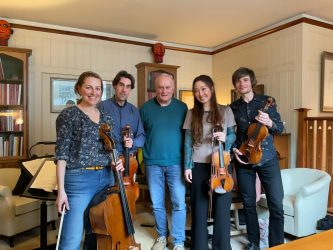United Kingdom Mozart, Britten: Sacconi Quartet (Ben Hancox, Haim Choi [violins], Robin Ashwell [viola], Cara Berridge [cello]). Wigmore Corridor, London, 31.3.2024. (CC)

Mozart – String Quartet in B-flat, Ok 589, ‘Prussian’ (1790)
Britten – String Quartet No.3, Op.94 (1975)
The Sacconi Quartet boasts an intensive discography, from Haydn and Beethoven by way of to Graham Fitkin and John McCabe. No Mozart, although, as but; however it was with Mozart this live performance started, the beautiful late B-flat Quartet, Ok 589.
The Sacconi Quartet’s common second violinist is listed on their web site as Hannah Dawson; the Sacconi Quartet is listed as a mentor of German-born South Korean violinist Haim Choi, who took the second violin spot as a substitute of Dawson – who’s on maternity go away – with nice success. Choi can be a member of the Salomé Quartet.
The primary motion of Ok 589 is among the perfect examples of dialog inside a string quartet: dialogues between devices, and groupings of devices abound; therefore, maybe, the hyperlink to Britten’s Third Quartet (whose first motion, ‘Duets’ is all about such mixtures). That grouping thought is there proper originally of Mozart’s masterpiece, with the viola as a type of pivot (violins and viola towards viola and cello); the younger Sacconi Quartet performed it with all of the maturity of an elder statesperson ensemble.
Famously, the so-called ‘Prussian’ Quartets foreground the cello at varied factors (King Friedrich Wilhelm II of Prussia, for whom these quartets have been written, was an newbie cellist). As music, Mozart’s Ok 589 is perfection itself; one thing that one definitely felt on this pretty efficiency. There have been many notable particular person contributions: Cara Berridge’s high-lying strains within the second motion Larghetto, some actually stunning phrasing from violist Robin Ashwell and a second violin half energetic from Choi. Perhaps solely often Ben Hancox’s first violin appeared not fairly as stable as his colleagues’ efforts; not fairly of the identical confidence degree, and his tone might generally err in direction of the cruel. Nonetheless, the finale was a second of equals, internal strains very good, contrasts finely calibrated.
Britten’s Third Quartet is a exceptional piece. Courting from 1975, this was the composer’s final main work. There are 5 actions, 4 of which have been written in Suffolk, the ultimate one at Lodge Danieli in Venice. It’s devoted to the nice musicologist Hans Keller and was premiered by the Amadeus Quartet at Snape Maltings in December 1976 (some two weeks after the composer’s loss of life).
Formally, there are a number of arches right here. Every motion is in ternary kind (ABA); the quartet as a complete has a gradual motion (‘Solo’) at its centre, surrounded by two quick actions (‘Ostinato’ and ‘Burlesque’), which are balanced by two outer gradual actions (‘Duets’ and ‘Recitative and Passacaglia (La Serenissima)’. ‘La Serenissima’ refers to Venice.
The challenges of the primary motion are many, however probably sustaining a pianissimo is the toughest, and one thing the Sacconi absolutely achieved. Britten’s machinations have been mesmeric; harmonics, too, glowed. Formally, the motion was completely honoured, the climax completely approached, the calm after the storm equally efficient.
There aren’t any lacking nods to Shostakovich on the opening of the second motion, ‘Ostinato’; the Sacconi efficiency was completely resolute right here, the continuation relentlessly decided. There’s an interesting rigour to Britten’s writing that got here by way of strongly. Particular person delights abounded: a second violin melody towards pizzicato cello, luminous chords elsewhere like mild by way of a stained-glass window. Britten performs with registral gaps within the third motion (‘Solo’) the excessive first violin towards chthonic cello (easing its manner slowly upwards, aspirationally). A particular point out for the management of violist Robin Ashwell on this motion, his contributions notably glorious. The fourth motion ’Burlesque’ introduced again shadows of Shostakovich, quickly interiorised into Britten’s world. The Sacconi was notably strong of their entries. It is a ‘danse macabre’, and definitely felt it. Lastly, ‘Recitative and Passacaglia’ – that Passacaglia holds no fewer than 5 references to Britten’s final opera Loss of life in Venice (1973). The finale accommodates Britten’s most superior writing of the work, additionally: textures are thinned to a minimal, a cello tread appears to indicate the inevitability of loss of life itself. It’s a exceptional piece, and this efficiency was itself exceptional.
Britten’s Third Quartet appears to deliver out one of the best in its performers: the final time I heard this work at Wigmore Corridor was with the Brentano String Quartet in 2016, one other glorious account as I recall. (So far as Britten’s Third Quartet is anxious, a chat given by Professor Roger Parker on this piece, adopted by an entire efficiency by the Badka String Quartet – accessible on YouTube – is completely beneficial listening.)
There was an inevitable encore: two to be correct, pleasant preparations by John Bowden of Previous Molly Oxford and Christchurch Bells launched by Ben Hancox, appositely, as ‘and now for one thing fully completely different’.
Colin Clarke

